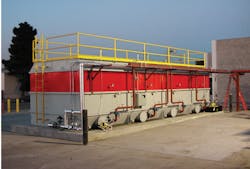Food processor will reuse wastewater thanks to Honeywell UOP clean water technology
DES PLAINES, IL, OCTOBER 25, 2016 -- Honeywell UOP announced today that its novel wastewater treatment technology will be used to help a fresh-cut fruit and vegetables company treat wastewater.
Honeywell UOP is delivering its modular XCeed™ bioreactor technology as part of a system to remove biological oxygen demand (BOD) from water that was used to clean and process fresh produce. The unit will treat roughly 150,000 gallons per day and return that water for reuse or for discharge, based on local discharge standards.
Honeywell UOP’s XCeed bioreactor technology removes organic and inorganic contaminants to help industrial, manufacturing and groundwater remediation facilities meet contaminant removal specifications for wastewater reuse or discharge. The modular technology was selected over other technologies due to its low sludge generation, greater energy efficiency and operational simplicity.
"Honeywell UOP is delivering this project as a modular turn-key solution, which is delivered quickly, and is less expensive and more reliable than field-constructed units," said Ken Stacherski, vice president and general manager of Honeywell UOP’s Catalysts, Adsorbents and Specialties business. "With more than 50 successful installations, the XCeed bioreactor system is a reliable and cost-effective solution for food and beverage companies, chemical and textile manufacturers, refinery and petrochemical facilities, and groundwater remediation to meet increasingly strict wastewater regulations and reuse requirements worldwide."
Honeywell UOP's expertise in bioreactor design, applied microbiology and process control makes possible extended biomass retention time, which improves the removal of organics and other targeted contaminants. As a result, through multiple applications over the last 25 years, the XCeed system has been shown to produce as much as 80 percent less sludge, consumes up to half as much energy and requires less maintenance and operator supervision than conventional technologies.
For more than a century, Honeywell UOP has been developing technologies for the world's oil and gas companies, including solutions for the separation and removal of contaminants in liquids and gases. For more information on Honeywell UOP's XCeed bioreactor technology, visit www.uop.com/water.
RELATED ARTICLES
XCeed™ bioreactor technology to be employed at Wy. refinery
Bioreactor Technology Tackles Tough Wastewater in Specialty Chemicals Application
About Honeywell UOP
Honeywell UOP is a leading international supplier and licensor of process technology, catalysts, adsorbents, equipment, and consulting services to the petroleum refining, petrochemical, and gas processing industries. Honeywell UOP is part of Honeywell’s Performance Materials and Technologies strategic business group, which also includes Honeywell Process Solutions (www.honeywellprocess.com), a pioneer in automation control, instrumentation and services for the oil and gas, refining, petrochemical, chemical and other industries.
About Honeywell
Honeywell (www.honeywell.com) is a Fortune 100 diversified technology and manufacturing leader, serving customers worldwide with aerospace products and services; control technologies for buildings, homes, and industry; turbochargers; and performSance materials.
